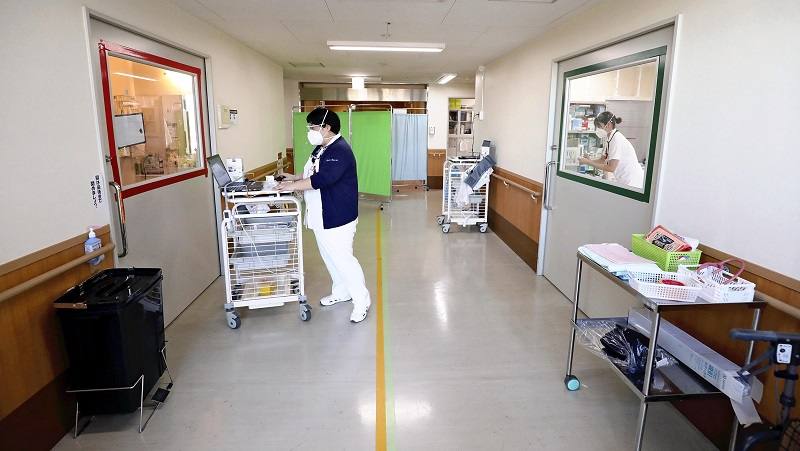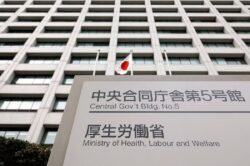
Red tape is seen on a door to a room for COVID patients, left, while the door to a staff station is taped in green at Shonan Kamakura General Hospital in Kamakura, Kanagawa Prefecture, on Wednesday.
7:00 JST, January 16, 2023
With Sunday marking three years since the first confirmed case of novel coronavirus infection in the nation, more hospitals are shifting toward co-existing with the virus.
Hospital beds are still scarce amid the ongoing eighth wave of COVID-19, and medical institutions are accelerating their efforts to overcome the situation by increasing the number of patients they can admit.
Treatment of chronic diseases
Shuzo Kobayashi, the director of Shonan Kamakura General Hospital in Kamakura, Kanagawa Prefecture, described the changes in how hospitals currently handle COVID patients, compared to the the seventh wave last summer.
“Hospitals can now focus on treating patients’ chronic illnesses, such as cardiac disease and cancer, even if they’re infected with the coronavirus,” Kobayashi said.
The 669-bed hospital strengthened its treatment system at the end of September of last year, after the seventh wave had subsided. Previously a limited number of physicians had treated all COVID patients, but the hospital switched to a system in which specialists in chronic diseases treat both those illnesses and the coronavirus if a patient is infected.
An increasing number of people in Japan are dying after infection with an omicron variant worsens their chronic illnesses, and this system allows the hospital’s patients to receive high-quality medical care from specialists.
Since the beginning of this year, there have been more than 100 emergency cases, including fever patients, per day at the Shonan Kamakura General Hospital. More than 70% of its 80 beds for coronavirus patients are occupied.
Kobayashi said the facility continues to be near its limit for admissions. However, “the number of patients who are seriously ill with pneumonia has decreased. The field of medical care also needs to make ‘co-existing with COVID’ a reality, balancing regular medical and coronavirus treatments,” he added.
Relaxing infection controls
With the relaxation of the central government’s guidelines for infection control in hospitals, an increasing number of facilities are securing new beds for coronavirus patients.
In June last year, the Health, Labor and Welfare Ministry notified hospitals that a “zoning” system — which separates areas where there is a risk of infection — can be applied on a room-by-room basis as well as on a ward-by-ward basis. Previously zoning had to be done by ward.
In response, Kanagawa Prefecture has since last summer called for admissions by hospitals that had not previously accepted COVID patients due to their limited facilities. Consequently, about 30 more hospitals in the prefecture started securing beds for such patients.
An increasing number of hospitals have been using beds previously secured for non-COVID patients to alleviate the short supply of beds.
Among about 44,000 coronavirus inpatients, 30%, or about 15,000, were being treated in beds for non-COVID patients as of Wednesday. This was up from the 10% peak during the sixth wave in the previous winter.
Local governments’ efforts can be cited as a factor in this trend. Osaka Prefecture has requested since last May that about 500 hospitals in the prefecture reserve about 10% of their hospital beds for patients who were diagnosed as being infected with COVID-19 after being admitted to the hospitals.
In a survey conducted in July last year, 80% of COVID hospitals had secured 10% of their beds for this purpose, while 60% of non-COVID hospitals had also done so.
Aichi Prefecture is also calling for medical institutions to treat COVID patients diagnosed after admittance as long as there is no risk of serious illness.
“We need to establish a system to care for new coronavirus infections in a way that removes any boundaries,” a prefectural official said.
"Society" POPULAR ARTICLE
-

M4.9 Earthquake Hits Tokyo, Neighboring Prefectures
-

M7.5 Earthquake Hits Northern Japan; Tsunami Waves Observed in Hokkaido, Aomori and Iwate Prefectures
-

Israeli Tourists Refused Accommodation at Hotel in Japan’s Nagano Pref., Prompting Protest by Israeli Embassy and Probe by Prefecture
-

Tsukiji Market Urges Tourists to Avoid Visiting in Year-End
-

M5.7 Earthquake Hits Japan’s Kumamoto Pref., Measuring Upper 5 Intensity, No Tsunami Expected
JN ACCESS RANKING
-

Keidanren Chairman Yoshinobu Tsutsui Visits Kashiwazaki-Kariwa Nuclear Power Plant; Inspects New Emergency Safety System
-

Imports of Rare Earths from China Facing Delays, May Be Caused by Deterioration of Japan-China Relations
-

University of Tokyo Professor Discusses Japanese Economic Security in Interview Ahead of Forum
-

Japan Pulls out of Vietnam Nuclear Project, Complicating Hanoi’s Power Plans
-

Govt Aims to Expand NISA Program Lineup, Abolish Age Restriction






















